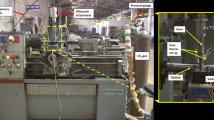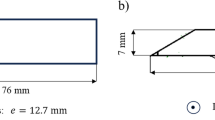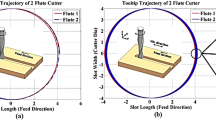Abstract
In cutting, the mechanical impact caused by material mechanics, geometric discontinuity, and intermittent cutting process is the main factor that induces cutting tool fracture. Impact fracture and fatigue failure of cutting tools are sudden, which can be harmful to safe production and quality control. In this paper, the effect mechanism of shim stiffness on the impact fracture performance of a tool in a mechanically clamped cutting tool system is studied. Furthermore, the vibration model of the tool-shim system is established to analyze the impact loading response characteristics of the tool-shim system under different stiffness shims. Meanwhile, the effect of shim stiffness on the loading rate, peak value, high-level fluctuation, unloading rate, and elastic energy release of shim elastic reaction force is explored. Apart from that, theoretical analysis of the stress field change near the tool crack tip is carried out. Finally, intermittent turning experiments are performed, including carbide inserts with four shims of N8 aluminum alloy, TC4 titanium alloy, 08 steel, and YT14 cemented carbide. Moreover, the analysis of each stage of the vibration response is verified. According to the results, the stiffness of the shim affects both the impact fracture of the tool basal body and the coating peeling. Besides, appropriately weakening the shim stiffness can reduce the load peak value of the shim elastic reaction force on the tool, the high load fluctuation amplitude, the unloading rate, and the dynamic stress intensity factor (DSIF), which can be conductive to improving the impact damage resistance of the tool.





























Similar content being viewed by others
Data availability
All authors declare that all data and material in this manuscript are transparently available.
References
Agmell M, Bushlya V, M’Saoubi R, Gutnichenko O, Zaporozhets O, Laakso S, Ståhl J (2020) Investigation of mechanical and thermal loads in PCBN tooling during machining of Inconel 718. Int J Adv Manuf Technol 107:1451–1462. https://doi.org/10.1007/s00170-020-05081-8
Corne R, Nath C, Mansori ME, Kurfess T (2016) Enhancing spindle power data application with neural network for real-time tool wear/breakage prediction during inconel drilling. Procedia Manuf 5:1–14. https://doi.org/10.1016/j.promfg.2016.08.004
Lu X, Jia Z, Wang H, Si L, Liu Y, Wu W (2016) Tool wear appearance and failure mechanism of coated carbide tools in micro-milling of Inconel 718 super alloy. Ind Lubr Tribol 68:267–277. https://doi.org/10.1108/ILT-07-2015-0114
Samotugin SS, Lavrinenko VI, Kudinova EV, Samotugina YS (2013) The study of fracture toughness and failure mechanisms of cutting-tool hardmetals with plasma-modified surface. J Superhard Mater 35:242–250. https://doi.org/10.3103/S1063457613040060
Liu K, Li XP, Liang SY (2007) The mechanism of ductile chip formation in cutting of brittle materials. Int J Adv Manuf Technol 33:875–884. https://doi.org/10.1007/s00170-006-0531-5
Cui X, Zhao J, Zhou Y, Zheng G (2013) Damage mechanics analysis of failure mechanisms for ceramic cutting tools in intermittent turning. Eur J Mech A/Solids 37:139–149. https://doi.org/10.1016/j.euromechsol.2012.06.002
Li H, Li J, Yuan H (2018) A review of the extended finite element method on macrocrack and microcrack growth simulations. Theor Appl Fract Mech 97:236–249. https://doi.org/10.1016/j.tafmec.2018.08.008
Denkena B, Grove T, Theuer M (2018) Micro crack formation in hardmetal milling tools. Int J Refract Met Hard Mater 70:210–214. https://doi.org/10.1016/j.ijrmhm.2017.10.008
Postek E, Sadowski T (2018) Distributed microcracking process of WC/Co cermet under dynamic impulse compressive loading. Compos Struct 194:494–508. https://doi.org/10.1016/j.compstruct.2018.04.014
Dai Z, Laheri V, Zhu X, Gilabert FA (2021) Experimental study of compression-tension asymmetry in asphalt matrix under quasi-static and dynamic loads via an integrated DMA-based approach. Constr Build Mater 283:122725. https://doi.org/10.1016/j.conbuildmat.2021.122725
Li X, Ashraf M, Li H, Zheng X, Wang H, Al-Deen S, Hazell P (2019) An experimental investigation on parallel bamboo strand lumber specimens under quasi static and impact loading. Constr Build Mater 228:116724. https://doi.org/10.1016/j.conbuildmat.2019.116724
Chen W, Lu F, Cheng M (2002) Tension and compression tests of two polymers under quasi-static and dynamic loading. Polym Test 21:113–121. https://doi.org/10.1016/S0142-9418(01)00055-1
Smirnov IV, Lamzin DA, Konstantinov AY, Brogov AM, Lomunov AK (2020) A unified experimental-theoretical approach to predict the critical stress characteristics of failure and yielding under quasi-static and dynamic loading. Eng Fract Mech 225:106197. https://doi.org/10.1016/j.engfracmech.2018.10.023
Zhang J, Deng H, Taheri A, Ke B, Liu C (2019) Deterioration and strain energy development of sandstones under quasi-static and dynamic loading after freeze-thaw cycles. Cold Reg Sci Technol 160:252–264. https://doi.org/10.1016/j.coldregions.2019.01.007
Mendoza I, Drury D, Matejunas A, Lvy J, Koumlis S, Jewell P, Brennecka G, Lamberson G (2021) Quasi-static and dynamic fracture behavior of lead zirconate titanate: a study of poling and loading rate. Eng Fract Mech 247:107669. https://doi.org/10.1016/j.engfracmech.2021.107669
Cun-jian L (2000) Effects of temperature and loading rate on fracture toughness of structural steels. Mater Des 21:27–30
Fan TY (2006) Principle and application of fracture dynamics. Beijing Institute of Technol Press
Kim Y, Chao YJ (2007) Effect of loading rate on dynamic fracture initiation toughness of brittle materials. Int J Fract 145:195–204. https://doi.org/10.1007/s10704-007-9114-1
Lang L, Zhu ZM, Wang HB, Huang J, Wang M, Zhang XS (2020) Effect of loading rates on crack propagating speed, fracture toughness and energy release rate using single-cleavage trapezoidal open specimen under impact loads. J Cent South Univ 27:2440–2454. https://doi.org/10.1007/s11771-020-4460-5
Yin T, Zhang S, Li X, Bai L (2018) A numerical estimate method of dynamic fracture initiation toughness of rock under high temperature. Eng Fract Mech 204:87–102. https://doi.org/10.1016/j.engfracmech.2018.09.034
Weerasooriya T, Moy P, Casem D, Cheng M, Chen W (2006) Fracture toughness for PMMA as a function of loading rate. Proc 2006 SEM Annu Conf Expo Exp Appl Mech 2:1048–1055
Cao L, Lin Y, Lu F, Chen R, Zhang Z, Li Y (2015) Experimental study on the shock absorption performance of combined aluminium honeycombs under impact loading. Shock Vib. https://doi.org/10.1155/2015/689546
Fleischer J, Becke C, Pabst R (2008) Improving tool life by varying resilience and damping properties in close proximity of the cutting edge. Prod Eng 2:357–364. https://doi.org/10.1007/s11740-008-0126-0
Moradi H, Movahhedy MR, Vossoughi G (2012) Dynamics of regenerative chatter and internal resonance in milling process with structural and cutting force nonlinearities. J Sound Vib 331:3844–3865. https://doi.org/10.1016/j.jsv.2012.03.003
Shuai G (2018) Tool life improvement using a shim with nanostructured composite damping coating synthesized by high power impulse magnetron sputtering. KTH Royal Ins Technol School
Pandya DH (2020) Experimental investigation of chatter in boring operation using shim
Rogov VA, Ghorbani S, Popikov AN, Polushin NI (2017) Improvement of cutting tool performance during machining process by using different shim. Arch Civ Mech Eng 17:694–710. https://doi.org/10.1016/j.acme.2017.01.008
Gandhi N, Pandya DH (2021) Computational investigation of chatter for face mill tool on VMC using different shim material with experimental validation. Adv Mater Manuf Energy Eng 1:1–9
Biggs JD (1964) Introduction to structural dynamics. McGraw Hill Publishing Company, New York, USA
Qudeiri JEA, Zaiout A, Mourad AHI, Abidi MH, Elkaseer A (2020) Principles and characteristics of different EDM processes in machining tool and die steels. Appl Sci 10:1–46. https://doi.org/10.3390/app10062082
Beri B, Meszaros G, Stepan G (2021) Machining of slender workpieces subjected to time-periodic axial force: stability and chatter suppression. J Sound Vib 504:116114. https://doi.org/10.1016/j.jsv.2021.116114
Wang X, Yao X, Hu G, Chen P (2019) Drag reduction performance of an axial oscillating tool with different kinds of waveform using a multiscale friction model. J Pet Sci Eng 177:135–153. https://doi.org/10.1016/j.petrol.2019.01.103
Zambrano OA (2021) A review on the effect of impact toughness and fracture toughness on impact-abrasion wear. J Mater Eng Perform 30:7101–7116. https://doi.org/10.1007/s11665-021-05960-5
Nowell D, Araújo JA (2002) The effect of rapidly varying contact stress fields on fretting fatigue. Int J Fatigue 24:763–775
Yan F, Liu X, He G, Zhang J, Yu Z (2012) Research on the tools’ strength in the condition of uncommonly dynamic heavy-duty loads. Adv Mater Res 500:563–568. https://doi.org/10.4028/www.scientific.net/AMR.500.563
Wang F, Zhao J, Li Z, Li A (2016) Coated carbide tool failure analysis in high-speed intermittent cutting process based on finite element method. Int J Adv Manuf Technol 83:805–813. https://doi.org/10.1007/s00170-015-7632-y
Zhang S, Li J, Zhu X, Lv H (2013) Saw-tooth chip formation and its effect on cutting force fluctuation in turning of Inconel 718. Int J Precis Eng Manuf 14:957–963. https://doi.org/10.1007/s12541-013-0126-7
Pekelharing AJ (1980) Cutting tool damage in interrupted cutting. Wear 62:37–48. https://doi.org/10.1016/0043-1648(80)90035-6
Hu Q, Liu X, Yan F, Cheng Y, Qiao S, He G, Sun S (2014) Research on the tools’ life in the dynamic heavy-duty cutting process. Key Eng Mater 589–590:327–331. https://doi.org/10.4028/www.scientific.net/KEM.589-590.327
Wang B, Liu Z, Song Q, Wan Y, Shi Z (2016) Proper selection of cutting parameters and cutting tool angle to lower the specific cutting energy during high speed machining of 7050–T7451 aluminum alloy. J Clean Prod 129:292–304. https://doi.org/10.1016/j.jclepro.2016.04.071
Rahmani H, Balootaki MA (2020) Studying the effect of pulse shape on dynamic stress intensity factor at the finite crack tip using displacement. Int J Adv Des Manuf Technol 13:109–117
Ingraffea AR, Manu C (1980) Stress-intensity factor computation in three dimensions with quarter-point elements. Int J Numer Methods Eng 15:1427–1445. https://doi.org/10.1002/nme.1620151002
Forth SC, Herman DJ, James MA, Johnston WM (2005) Fatigue crack growth rate and stress-intensity factor corrections for out-of-plane crack growth. J ASTM Int. https://doi.org/10.1520/JAI12026
Wang Y, Zhou X, Kou M (2019) An improved coupled thermo-mechanic bond-based peridynamic model for cracking behaviors in brittle solids subjected to thermal shocks. Eur J Mech A/Solids 73:282–305. https://doi.org/10.1016/j.euromechsol.2018.09.007
Yu H, Chen X, Sun Y (2020) A generalized bond-based peridynamic model for quasi-brittle materials enriched with bond tension–rotation–shear coupling effects. Comput Methods Appl Mech Eng 372:113405. https://doi.org/10.1016/j.cma.2020.113405
Panchadhara R, Gordon PA (2016) Application of peridynamic stress intensity factors to dynamic fracture initiation and propagation. Int J Fract 201:81–96. https://doi.org/10.1007/s10704-016-0124-8
Zheng G, Xu R, Cheng X, Zhao G, Li L, Zhao J (2018) Effect of cutting parameters on wear behavior of coated tool and surface roughness in high-speed turning of 300M. Meas J Int Meas Confed 125:99–108. https://doi.org/10.1016/j.measurement.2018.04.078
Orra K, Choudhury SK (2018) Tribological aspects of various geometrically shaped micro-textures on cutting insert to improve tool life in hard turning process. J Manuf Process 31:502–513. https://doi.org/10.1016/j.jmapro.2017.12.005
Shokrani A, Al-Samarrai I, Newman ST (2019) Hybrid cryogenic MQL for improving tool life in machining of Ti-6Al-4V titanium alloy. J Manuf Process 43:229–243. https://doi.org/10.1016/j.jmapro.2019.05.006
Yildirim ÇV, Kivak T, Sarikaya M, Şirin Ş (2020) Evaluation of tool wear, surface roughness/topography and chip morphology when machining of Ni-based alloy 625 under MQL, cryogenic cooling and CryoMQL. J Mater Res Technol 9:2079–2092. https://doi.org/10.1016/j.jmrt.2019.12.069
Martin ML, Fenske JA, Liu GS, Sofronis P, Robertson LM (2011) On the formation and nature of quasi-cleavage fracture surfaces in hydrogen embrittled steels. Acta Mater 59:1601–1606. https://doi.org/10.1016/j.actamat.2010.11.024
Bianchetti C, Zheng R, Chromik RR, Lévesque M, Brochu M (2018) Comparison of small and long fatigue crack growth behavior in AA 7050–T7451. Eng Fract Mech 202:20–32. https://doi.org/10.1016/j.engfracmech.2018.09.009
Ogawa Y, Birenis D, Matsunaga H, Takakuwa O, Yamabe J, Prytz Ø, Thøgersen A (2018) The role of intergranular fracture on hydrogen-assisted fatigue crack propagation in pure iron at a low stress intensity range. Mater Sci Eng A 733:316–328. https://doi.org/10.1016/j.msea.2018.07.014
Wang T, Zha X, Chen F, Wang J, Lin L, Xie H, Lin F, Jiang F (2021) Research on cutting performance of coated cutting tools by a new impact test method considering contact stress condition caused by segmented chips. J Manuf Process 68:1569–1584. https://doi.org/10.1016/j.jmapro.2021.07.001
Funding
This work was supported by the National Natural Science Foundation of China (52075275, 51675289), Key Research and Development Plan of Shandong Province (2018GGX103023).
Author information
Authors and Affiliations
Contributions
Hongwei Zhang: writing — original draft, writing — review & editing. Guosheng Su: conceptualization, writing — review & editing, project administration. Zhitao Han: validation. Jialin Sheng: methodology. Peirong Zhang: methodology. Hongxia Zhang: formal analysis.
Corresponding author
Ethics declarations
Consent to participate
All authors consent to their participation in the research of this manuscript.
Consent for publication
All authors consent to publish the research content of this paper.
Conflict of interest
The authors declare no competing interests.
Additional information
Publisher's Note
Springer Nature remains neutral with regard to jurisdictional claims in published maps and institutional affiliations.
Rights and permissions
Springer Nature or its licensor holds exclusive rights to this article under a publishing agreement with the author(s) or other rightsholder(s); author self-archiving of the accepted manuscript version of this article is solely governed by the terms of such publishing agreement and applicable law.
About this article
Cite this article
Zhang, H., Su, G., Han, Z. et al. Influences of shim stiffness on the vibration response of tool-shim system and the impact fracture resistance of cutting tool in intermittent cutting. Int J Adv Manuf Technol 123, 571–589 (2022). https://doi.org/10.1007/s00170-022-10183-6
Received:
Accepted:
Published:
Issue Date:
DOI: https://doi.org/10.1007/s00170-022-10183-6




